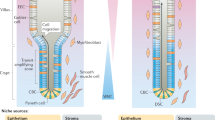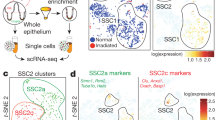Abstract
‘Adult’ or ‘somatic’ stem cells harbor an intrinsic ability to regenerate tissues. Heterogeneity of such stem cells along the gastrointestinal tract yields the known segmental specificity of this organ and may contribute to the pathology of certain enteric conditions. Here we detail technology for the generation of ‘libraries’ of clonogenic cells from 1-mm-diamter endoscopic biopsy samples from the human gastrointestinal tract. Each of the 150–300 independent clones in a typical stem cell library can be clonally expanded to billions of cells in a few weeks while maintaining genomic stability and the ability to undergo multipotent differentiation to the specific epithelia from which the sample originated. The key to this methodology is the intrinsic immortality of normal intestinal stem cells (ISCs) and culture systems that maintain them as highly immature, ground-state ISCs marked by a single-cell clonogenicity of 70% and a corresponding 250-fold proliferative advantage over spheroid technologies. Clonal approaches such as this enhance the resolution of molecular genetics, make genome editing easier, and may be useful in regenerative medicine, unravelling heterogeneity in disease, and facilitating drug discovery.
This is a preview of subscription content, access via your institution
Access options
Access Nature and 54 other Nature Portfolio journals
Get Nature+, our best-value online-access subscription
$29.99 / 30 days
cancel any time
Subscribe to this journal
Receive 12 print issues and online access
$259.00 per year
only $21.58 per issue
Buy this article
- Purchase on Springer Link
- Instant access to full article PDF
Prices may be subject to local taxes which are calculated during checkout






Similar content being viewed by others
Data availability
The corresponding authors will provide all data presented in the article and address technical questions upon reasonable request.
References
Karagiannis, P. et al. Induced pluripotent stem cells and their use in human models of disease and development. Physiol. Rev. 99, 79–114 (2019).
Müller, A. M. & Dzierzak, E. A. ES cells have only a limited lymphopoietic potential after adoptive transfer into mouse recipients. Development 118, 1343–1351 (1993).
Helgason, C. D., Sauvageau, G., Lawrence, H. J., Largman, C. & Humphries, R. K. Overexpression of HOXB4 enhances the hematopoietic potential of embryonic stem cells differentiated in vitro. Blood 87, 2740–2749 (1996).
Amabile, G. et al. In vivo generation of transplantable human hematopoietic cells from induced pluripotent stem cells. Blood 121, 1255–1264 (2013).
Suzuki, N. et al. Generation of engraftable hematopoietic stem cells from induced pluripotent stem cells by way of teratoma formation. Mol. Ther. 21, 1424–1431 (2013).
Green, H. The birth of therapy with cultured cells. BioEssays 30, 897–903 (2008).
Senoo, M., Pinto, F., Crum, C. P. & McKeon, F. p63 is essential for the proliferative potential of stem cells in stratified epithelia. Cell 129, 523–536 (2007).
Rama, P. et al. Limbal stem-cell therapy and long-term corneal regeneration. N. Engl. J. Med. 363, 147–155 (2010).
Kumar, P. A. et al. Distal airway stem cells yield alveoli in vitro and during lung regeneration following H1N1 influenza infection. Cell 147, 525–538 (2011).
Hirsch, T. et al. Regeneration of the entire human epidermis using transgenic stem cells. Nature 551, 327–332 (2017).
Wang, X. et al. Cloning and variation of ground state intestinal stem cells. Nature 522, 173–178 (2015).
Yamamoto, Y. et al. Mutational spectrum of Barrett’s stem cells suggests paths to initiation of a precancerous lesion. Nat. Commun. 7, 10380 (2016).
Duleba, M. et al. An efficient method for cloning gastrointestinal stem cells from patients via endoscopic biopsies. Gastroenterology 156, 20–23 (2018).
Rheinwald, J. G. & Green, H. Serial cultivation of strains of human epidermal keratinocytes: the formation of keratinizing colonies from single cells. Cell 6, 331–343 (1975).
Rheinwald, J. G. & Green, H. Formation of a keratinizing epithelium in culture by a cloned cell line derived from a teratoma. Cell 6, 317–330 (1975).
Barrandon, Y. & Green, H. Cell migration is essential for sustained growth of keratinocyte colonies: the roles of transforming growth factor-α and epidermal growth factor. Cell 50, 1131–1137 (1987).
Barrandon, Y. & Green, H. Cell size as a determinant of the clone-forming ability of human keratinocytes. Proc. Natl Acad. Sci. USA 82, 5390–5394 (1985).
Xian, W., Duleba, M., Yamamoto, Y., Vincent, M. & McKeon, F. Biobanking organoids or ground-state stem cells? J. Clin. Med. 7, 555 (2018).
Yin, X. et al. Niche-independent high-purity cultures of Lgr5+ intestinal stem cells and their progeny. Nat. Methods 11, 106–112 (2014).
Hong, S. N., Dunn, J. C. Y., Stelzner, M. & Martín, M. G. Concise review: the potential use of intestinal stem cells to treat patients with intestinal failure. Stem Cells Transl. Med. 6, 666–676 (2017).
Fukuda, M. et al. Small intestinal stem cell identity is maintained with functional Paneth cells in heterotopically grafted epithelium onto the colon. Genes Dev. 28, 1752–1757 (2014).
Simian, M. & Bissell, M. J. Organoids: a historical perspective of thinking in three dimensions. J. Cell Biol 216, 31–40 (2017).
Sato, T. et al. Single Lgr5 stem cells build crypt-villus structures in vitro without a mesenchymal niche. Nature 459, 262–265 (2009).
Wang, F. et al. Isolation and characterization of intestinal stem cells based on surface marker combinations and colony-formation assay. Gastroenterology 145, 383–395.e21 (2013).
Todaro, G. J. & Green, H. Quantitative studies of the growth of mouse embryo cells in culture and their development into established lines. J. Cell Biol. 17, 299–313 (1963).
Acknowledgements
This work was supported by grants from the Cancer Prevention Research Institute of Texas (CPRIT; RR15014 to W.X. and RR15088 to F.M.), the National Institutes of Health (1R01DK115445-01A1 to W.X.; U24CA228550 and 1R01CA241600-01 to F.M.), the US Dept. of Defense (W81XWH-17-1-0123 to W.X.; W81XWH-19-1-0127 to C.P.C.), the Singapore National Medical Research Council (to K.Y.H. and F.M.), a University of Texas Presidential Award (to W.X.) and an American Gastroenterology Association Research and Development Pilot Award in Technology (to W.X.). W.X. and F.M. are CPRIT Scholars for Cancer Research. We thank all the members of the Xian–McKeon laboratory for helpful discussions and support. We thank H. Green and J. Rosen for advice and support. We thank H. Green for the generous gift of the 3T3-J2 fibroblast cell line.
Author information
Authors and Affiliations
Contributions
W.X., Y.Y., M.D. and F.M. wrote the manuscript with input from all other authors. J.A.A., K.Y.H., J.K.H., J.S.H., F.A.S. and C.P.C. provided biopsy material; M.D., Y.Y., Y.Z. and R.N. cloned gISCs; J.X., S.W. and R.M. performed informatics analyses; A-A.L., Y.Q. and K.G. performed xenografts and ALI cultures; W.R. and R.N. performed the FACS analyses; and all authors collaborated on the concepts of this work.
Corresponding authors
Ethics declarations
Competing interests
W.X., F.M., M.D. and M.V. have filed patents related to the technology used in the present work. W.X., M.V. and F.M. have financial interests in Tract Pharmaceuticals, Inc.
Additional information
Publisher’s note Springer Nature remains neutral with regard to jurisdictional claims in published maps and institutional affiliations.
Related links
Key references using this protocol
Wang, X. et al. Nature 522, 173–178 (2015): https://doi.org/10.1038/nature14484
Duleba, M. et al. Gastroenterology 156, 20–23 (2019): https://doi.org/10.1053/j.gastro.2018.08.062
Yamamoto, Y. et al. Nat. Commun. 7, 10380 (2016): https://doi.org/10.1038/ncomms10380
Integrated supplementary information
Supplementary Fig. 1 FACS profiling of unlabeled gISCs.
Left, Debris removed by forward scatter (FSC) vs back scatter (BSC). Middle, Singlet selection using singlets are gated using FSC area (FSC-A) versus FSC width (FSC-W). Right, Selection of GFP-positive cells using FITC-A versus BSC-A.
Supplementary Fig. 2 FACS profiling of unlabeled 3T3-J2 cells.
Left, Debris removed by forward scatter (FSC) vs back scatter (BSC). Middle, Singlet selection using singlets are gated using FSC area (FSC-A) versus FSC width (FSC-W). Right, Selection of GFP-positive cells using FITC-A versus BSC-A.
Supplementary Fig. 3 FACS profiling of GFP-gISC/3T3-J2 co-cultures.
Left, Debris removed by forward scatter (FSC) vs back scatter (BSC). Middle, Singlet selection using singlets are gated using FSC area (FSC-A) versus FSC width (FSC-W). Right, Selection of GFP-positive cells using FITC-A versus BSC-A.
Supplementary Fig. 4 FACS profiling of GFP-gISC/3T3-J2 co-cultures following removal of 3T3-J2 cells.
Left, Debris removed by forward scatter (FSC) vs back scatter (BSC). Middle, Singlet selection using singlets are gated using FSC area (FSC-A) versus FSC width (FSC-W). Right, Selection of GFP-positive cells using FITC-A versus BSC-A.
Supplementary information
Supplementary Information
Supplementary Figs. 1–4, Supplementary Table 1 and Supplementary Methods.
Supplementary Video 1
Time lapse of colony growth from gISCs in vitro.
Supplementary Video 2
Clonal expansion of gISCs in vitro.
Rights and permissions
About this article
Cite this article
Duleba, M., Yamamoto, Y., Neupane, R. et al. Cloning of ground-state intestinal stem cells from endoscopic biopsy samples. Nat Protoc 15, 1612–1627 (2020). https://doi.org/10.1038/s41596-020-0298-4
Received:
Accepted:
Published:
Issue Date:
DOI: https://doi.org/10.1038/s41596-020-0298-4
This article is cited by
-
Colonic stem cells from normal tissues adjacent to tumor drive inflammation and fibrosis in colorectal cancer
Cell Communication and Signaling (2023)
Comments
By submitting a comment you agree to abide by our Terms and Community Guidelines. If you find something abusive or that does not comply with our terms or guidelines please flag it as inappropriate.



